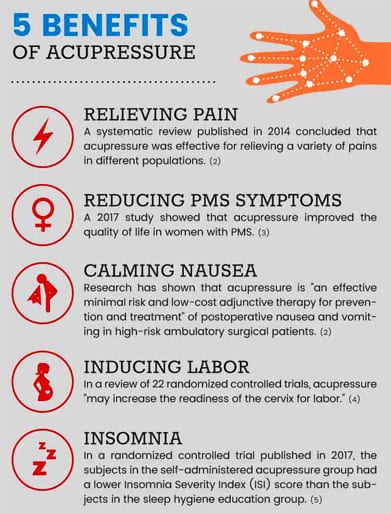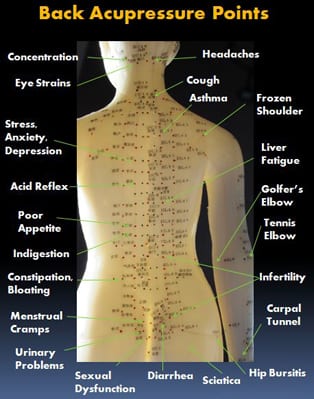Acupressure. A bit of History
Blue indicates link 
Originating in China over 5,000 years ago, acupressure is considered one of the ancient arts of healing. Similar to acupuncture, it works around the principle of stimulating the body’s self-healing abilities by regulating the flow of the body’s life force known as chi. It is a belief in traditional Chinese medicine that the chi flows through the body’s pathways known as “meridians”, and a disruption in this flow can cause discomfort and even illness.
Benefits
Boost in the immune system.
Acupressure therapy employs gentle to firm pressure that when applied to specific potent points can improve blood circulation, release muscle tension, and aid in the body’s detoxification, which, improves the body’s natural healing capabilities and resistance to diseases.
Youthfulness and beauty.
Traditionally, the Chinese have used acupressure as a beauty treatment. By applying finger pressures, the therapy has been known to increase circulation, tone the facial muscles, prevent wrinkles, and release toxins.
Better sexual drive.
Acupressure can improve arousal, and sexual endurance, and enhance sexual pleasure. It can even help with sexual problems, such as decreased libido, impotency, premature ejaculation, and infertility through a deeper understanding of how to release blocked sexual energies.
Mental and emotional wellness.
Aside from the physical benefits of acupressure, it has been known to alleviate emotional and mental pain as well. From day-to-day work conflicts to trauma caused by abuse, divorce, and death, all of these negative feelings are kept buried, which can cause physical and emotional imbalances. These stresses can cause the body’s muscles to tighten and contract, preventing the life energy from flowing freely. This may lead to depression, anxiety, and other disorders.
Acupressure can bring an overall feeling of wellness by promoting positive thoughts, relaxing the muscles, and relieving any associated symptoms of stress.
Used to Treat
Most people try acupressure for the first time to manage symptoms of a condition, such as:
Cancer-related fatigue and other forms of fatigue
Menstrual cramps
Motion sickness
Muscle tension and pain
Nausea or vomiting after surgery or chemotherapy
Nausea and vomiting during pregnancy and morning sickness
Stress management
Effectiveness

There’s currently a lack of studies exploring the effectiveness of acupressure. Still, some evidence suggests wrist acupressure may help relieve pain after a sports injury.
In a 2017 study published in the Clinical Journal of Sports Medicine, for instance, researchers examined the effects of three minutes of acupressure, three minutes of sham acupressure, or no acupressure in athletes who had sustained a sports injury on the same day.
The study concluded that acupressure was effective in reducing pain intensity compared to sham acupressure or no acupressure. There was no change in anxiety.
Acupressure may help ease nausea and vomiting in those with chemotherapy-induced nausea and vomiting, according to a report published in CA: A Cancer Journal for Clinicians.
Researchers analyzed the results of three previously published trials and found that acupressure (using finger pressure or an acupressure wristband) decreased nausea, vomiting, and retching.
In a report published in the Cochrane Database of Systematic Reviews, scientists analyzed 22 previously published clinical trials on acupuncture or acupressure for the induction of labor and found no clear benefit in reducing cesarean section rates.
How Does Acupressure Work?
Acupressure practitioners use their fingers, palms, elbows feet, or special devices to apply pressure to acupoints on the body’s meridians. Sometimes, acupressure also involves stretching or acupressure massage, as well as other methods.
During an acupressure session, you lie fully clothed on a soft massage table. The practitioner gently presses on acupressure points on your body. A session typically lasts about one hour. You may need several sessions for the best results.
The goal of acupressure or other types of Asian bodywork is to restore health and balance to the body’s channels of energy and to regulate opposing forces of yin (negative energy) and yang (positive energy). Some proponents claim acupressure not only treats the energy fields and body but also the mind, emotions, and spirit. Some even believe that therapists can transmit vital energy (external qi) to another person.
Not all Western practitioners believe that this is possible or even that these meridians exist. Instead, they attribute any results to other factors, such as reduced muscle tension, improved circulation, or stimulation of endorphins, which are natural pain relievers.
How to Administer Acupressure
- Use deep, firm pressure to massage and stimulate each point.
- When massaging acupoints, try to relax in a comfortable position, close your eyes, and breathe deeply.
- Repeat the massage as often as you like; there is no limit to the number of times a day.
- Besides massaging these points on yourself, anyone can also help massage these points for you.
What Are Some of the Common Acupressure Points to Learn?
Here is a list of eight commonly used acupressure points. Click the name to learn when to use each of the points and how to locate it.
Gallbladder 20 (GB20)
This point is recommended for headaches, migraines, eye blurriness or fatigue, low energy, and cold/flu symptoms. It is located by feeling the mastoid (ear) bone and following the groove back to where the neck muscles attach to the skull.
Gallbladder 21 (GB21): Jian Jing
This point is located by pinching the shoulder muscle with your thumb and middle finger and is commonly used for stress, facial pain, headaches, toothaches, and neck pain. Use with caution in pregnant women.
Large Intestine 4 (LI4): He Gu
This point is good for stress, headaches, toothaches, facial pain, and neck pain. However, as a word of precaution, it can induce labor and must never be used during pregnancy.
Liver
You need to take off your shoes to find this point. This is an excellent area to stimulate stress, low back pain, high blood pressure, limb pain, insomnia, and emotional upset.
Pericardium 6 (P6): Nei Guan
This point can help provide relief for nausea, anxiety, carpal tunnel syndrome, upset stomach, motion sickness, and headaches and is even used for the regulation of heart palpitations.
Triple Energizer 3: Zhong Zhu
This point is located in the groove formed by the tendons of the 4th and 5th fingers, behind the knuckles, and is commonly used in the clinic for temporal headaches, shoulder and neck tension, and upper back pain.
Spleen 6 (SP6): San Yin Jiao
This point can be very helpful for many urological and pelvic disorders as well as fatigue and insomnia. Avoid during pregnancy.
Stomach36 (ST36): Zu San Li
You can find this point useful for fatigue and depression as well as knee pain and gastrointestinal discomfort. Asians frequently stimulate this point for health promotion and longevity.
How to Perform Acupressure
Step 1: Identify your health problem.
Step 2: Find the right points.
Step 3: Start poking them!
Let’s Learn Acupressure

The two fundamental steps to acupressure are choosing the right acupoints to use, and stimulating those points with physical pressure.
When it comes to stimulation techniques, there are several variables such as the amount of pressure that you put on a point, whether your fingers are static or using a rubbing motion, and whether you prefer using your hands.
You can also vary the length of time that you apply pressure to each point, with some books recommending anywhere from one minute to ten minutes of pressure per acupoint.
The pressure you apply should not be strong enough to cause actual pain, although deep pressure may cause temporary muscle soreness.
You should only use gentle pressure on an acupoint if you have an injury in that location, such as a cut or bruise.
Choosing Your Method
Preferences for all of the above options differ among practitioners, but since acupressure is easy to learn, free to use, and quick to apply, you can try them all out yourself and see which methods you prefer.
I recommended starting out by following a video guide to get some practice with the basics.
I’ve gathered a few videos here so that you can follow along as you learn.
Video 1: Acupressure for Stress Relief
Video 2: Acupressure for Back Pain Relief
These videos are just a taste of the free educational material that is available online.
I encourage you to look up free acupressure training videos on YouTube or elsewhere for the specific health condition or mental problem that you are trying to relieve.
Always consult with your doctor before trying alternative medicine.
For Images of Acupressure Points visit the link below
https://www.pinterest.ca/sherardm/acupressure/
Thank you for reading
Michael
Comments are welcome
I love how informative this article is. It has opened my eyes to acupressure. The benefits are astounding. I was really surprised after reading everything. Youth and beauty? That benefit must grab a lot of women who read this article. Mental health? We all need help with that. The detailed information on what acupressure involves is very good.
This was a good read. Thanks for sharing.
Hi Toni,
Thank you for your comments. Glad you found the information helpful.
All the best,
Michael